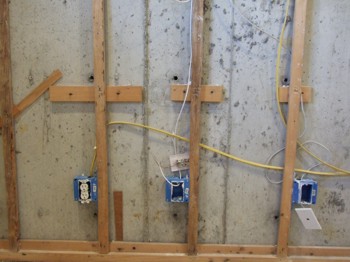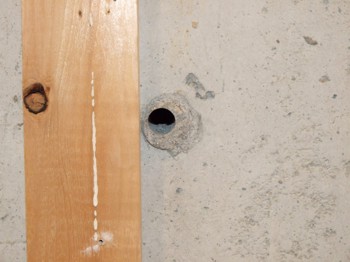Concrete Repair
DEAR TIM: I’ve got an unexpected concrete repair I have to make to my poured concrete foundation. A water leak caused me to have to remove drywall in my basement. To my surprise, I discovered rows of holes 5/8-inch diameter in my concrete walls, some that have water dripping through them. These perfectly drilled holes are not random, and are as deep as the foundation is thick. What created them? How can I patch them so they don’t leak? What’s the best material to use when doing concrete repair for cracks or holes like this? Bryan R., Cincinnati, OH
DEAR BRYAN: The gremlin that created those holes worked at your home years ago in broad daylight. The holes were not drilled, they were created by smooth steel rods that were part of the foundation form panels that were used to create your concrete foundation.

These rods passed through the concrete forms. Slots at each end of the rod held a steel pin that prevented the concrete forms from expanding outwards under the enormous weight and pressure of the fluid concrete that filled the forms to create your foundation walls. Once the concrete set and was hard, the form panels were removed and the rods tapped out with a hammer leaving these holes with the smooth bore.
I have to believe that the foundation contractor used a concrete repair product at the very least on the outside face of your foundation that’s now covered with dirt. Unfortunately, he may have used the wrong thing for basement concrete repair.
There are many concrete repair products out there, but my personal favorite for this situation is a powder that contains Portland cement, bentonite clay and some other ingredients that cause the patching material to get hard quickly and expand at the same time. Bentonite is a fine clay that expands when it gets wet.

This hole in a concrete wall can be repaired permanently with the right product and technique. PHOTO CREDIT: Bryan Rubenthal
Many homeowners might try to repair and patch these holes with bricklayer’s mortar or just a mixture of Portland cement and sand. Or they may think that an epoxy concrete repair is even stronger. The trouble is regular mortar or Portland cement shrinks ever so slightly as it hardens and cures. This creates a tiny pathway for water to enter through the holes.
You need a product that actually expands as it cures, much like you see spray foam insulation. If you’ve ever used this foam you know it goes into a crack one size but hours later it’s much bigger as the foam has hardened.
These expanding hydraulic concrete repair cement products are readily available at hardware stores, building supply businesses and home centers. They come as a dry powder in a can and will clearly say on the label that they expand as they harden. This is mission critical. Look for that on the label.
One such product is Waterplug Hydraulic Cement. (Please read my opens in a new windowDisclosure Policy about products I recommend.)
These products often contain ingredients that cause them to harden pretty quickly. It’s not uncommon to have a work time measured in just a few minutes not hours. I’d only mix up what I could use in ten minutes. You can sometimes extend the work time by refrigerating the powder to get it cold and using very cold water as you mix it.
Be sure to vacuum out the holes and remove all debris. If you can insert a small bottle brush to get out any dust or silt that’s on the concrete, this will really help ensure patching success. You want the concrete surface in each hole to be perfectly clean with no dust, dirt or debris.
Just before filling each hole with the expanding concrete repair product, use an old spray bottle and spritz the hole with a spray of clean water. You want the surface of the inside of the hole to be slightly damp. This will really help the patching material bond with the dry concrete.
If you have running water coming through the holes now, try to wait for a dry spell to do the repair. Some of these hydraulic repair cements will work if there is moving water, but it’s not always guaranteed.
You don’t need to fill the rod hole to it’s complete depth with the repair material. If you just get it into the hole about 2 inches, that should be plenty.
Once the material hardens after about 30 minutes, try to keep it damp by spritzing the concrete wall around the hole with the spray bottle and clear water. If you can keep the repair compound wet for at least 24 hours or more, it will really help create a strong and permanent repair.
Column 868